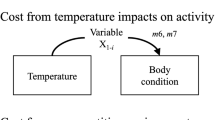Summary
We studied 13 ruff leks in a small region on the island of Gotland (Sweden) to investigate the effect of lek size on the costs and benefits of lekking for individual males. Male ruffs occur in two behaviourally and morphologically distinct forms, “independents” (“residents” plus “marginals”) and “satellites”, whose costs and benefits we have assessed separately. These ruff leks had from 1–10 resident (territory-holding) males and were visited daily by satellites, marginals and females from 5–25 May, when most copulations occurred. We used the average number of independent males, counted during censuses taken every 5 min during 2-h observation periods at each lek, as an index of mean lek size. Per independent male, the numbers of both satellites and females increased significantly with mean lek size. Female arrival rate and attendance (total female-minutes) also increased significantly with mean lek size as did the average per capita rate of mating success for resident males (that of satellites was not quite significant). Thus, the dispersion of both of these male categories did not appear to fit an ideal free distribution with respect to mating success. In addition, the number of independent-independent fights per independent and the rate of satellite-resident dyad formation per resident increased significantly with mean lek size. These results suggest that ruffs on larger leks enjoy higher mating success than those on smaller leks but also that costs increase with lek size. We suggest that independent males distribute themselves so as to maximize their own net benefits and that this factor can account for both the occurrence of ruff leks and the variation in their size.
Similar content being viewed by others
References
Alatalo RV, Höglund J, Lundberg A, Sutherland WJ (1992) Evolution of black grouse leks: female preferences benefit males in larger leks. Behav Ecol 3:53–59
Alexander RD (1975) Natural selection and specialized chorusing behavior in acoustical insects. In: Pimentel D (ed) Insects, science and society. Academic Press, New York, pp 35–77
Arak A (1984) Sneaky breeders. In: Barnard CJ (ed) Producers and scroungers: strategies of exploitation and parasitism. Croom Helm, Beckenham, pp 154–194
Arak A (1988) Callers and satellites in the natterjack toad: evolutionary stable decision rules. Anim Behav 36:416–432
Balmford AP (1990) Lekking in Uganda kob. Ph D thesis. Cambridge University
Beehler BM, Foster MS (1988) Hotshots, hotspots, and the organization of lek mating systems. Am Nat 131:203–219
Borgia G (1979) Sexual selection and the evolution of mating systems. In: Blum MS, Blum NA (eds) Sexual selection and reproductive competition in insects. Academic Press, New York, pp 19–80
Bradbury JW (1981) The evolution of leks. In: Alexander RD, Tinkle DW, (eds) Natural selection and social behavior: recent research and new theory. Chiron Press, New York, pp 138–169
Bradbury JW, Davies NB (1987) Relative roles of intra- and intersexual selection. In: Bradbury JW, Andersson MB (eds) Sexual selection: testing the alternatives. John Wiley,Chichester, pp 143–163
Bradbury JW, Gibson RM (1983) Leks and mate choice. In: Bateson P (ed) Mate choice. Cambridge Univ Press, Cambridge, pp 109–138
Bradbury JW, Gibson RM, Tsai IM (1986) Hotspots and the dispersion of leks. Anim Behav 34:1694–1709
Bradbury JW, Gibson RM, McCarthy CE, Vehrencamp SL (1989) Dispersion of displaying sage grouse. II. The role of female dispersion. Behav Ecol Sociobiol 24:15–24
Fretwell SD, Lucas HL (1970) On territorial behavior and other factors influencing habitat distribution in birds. Acta Biotheor 19:16–36
Gibson RM, Taylor CE, Jefferson DR (1990) Lek formation by female choice: a simulation study. Behav Ecol 36:42
Hibino Y (1986) Female choice for male gregariousness in a stink bug, Megacopta punctatissimum (Montadon) (Heteroptera, Plataspidae). J Ethel 4:91–95
Hogan-Warburg AJ (1966) Social behaviour of the ruff Philoma-chus pugnax (L.). Ardea 54:109–229
Hoglund J, Robertson JGM (1990) Female preferences, male decision rules and the evolution of leks in the great snipe Gallinago media. Anim Behav 40:15–22
Houston AI, McNamara JM (1988) The ideal free distribution when competitive abilities differ: an approach based on statistical mechanics. Anim Behav 36:166–174
Lack D (1968) Ecological adaptations for breeding in birds. Chapman and Hall, London
Lank DB, Smith CM (1987) Conditional lekking in the ruff (Philomachuspugnax). Behav Ecol Sociobiol 20:137–145
Lank DB, Smith CM (1992) Females prefer larger leks. Field experiments with ruffs, Philomachus pugnax. Behav Ecol Sociobiol 30:323–329
Otte D (1974) Effects and functions in the evolution of signalling systems. Annu Rev Ecol Syst 5:385–416
Parker GA, Sutherland WJ (1986) Ideal free distribution when individuals differ in competitive ability: phenotype-limited ideal free models. Anim Behav 34:1222–1242
Queller DC (1987) The evolution of leks through female choice. Anim Behav 35:1424–1432
Shelly TE (1990) Waiting for mates: variation in female encounter rates within and between leks of Drosophila conformis. Behaviour 107:34–48
Sokal RR, Rohlf J (1981) Biometry. WH Freeman, San Francisco
Sutherland WJ (1983) Aggregation and the ‘ideal free’ distribution. J Anim Ecol 52:821–828
Sutherland WJ, Parker GA (1985) Distribution of unequal competitors. In: Sibly RM, Smith RH (eds) Behavioural ecology: ecological consequences of adaptive behaviour. Blackwell, Oxford, pp 225–274
Svensson BG, Pettersson E (1992) Why insects swarm: testing the models for lek mating systems on swarming Empis borealis. Behav Ecol Sociobiol 31:253–261
van Rhijn JG (1983) On the maintenance and origin of alternative mating strategies in the ruff (Philomachus pugnax). Ibis 125:482–498
van Rhijn JG (1991) The ruff: individuality in a gregarious wading bird. Poyser, London
Vehrencamp SL, Bradbury JW, Gibson RM (1989) The energetic cost of display in male sage grouse. Anim Behav 38:885–896
Wittenberger JF (1978) The evolution of mating systems in grouse. Condor 80:126–137
Author information
Authors and Affiliations
Additional information
Correspondence to: J. Höglund
Rights and permissions
About this article
Cite this article
Höglund, J., Montgomerie, R. & Widemo, F. Costs and consequences of variation in the size of ruff leks. Behav Ecol Sociobiol 32, 31–39 (1993). https://doi.org/10.1007/BF00172220
Received:
Accepted:
Issue Date:
DOI: https://doi.org/10.1007/BF00172220




